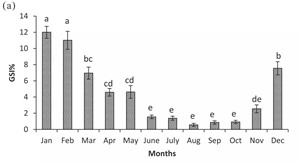Goldspot mullet, Liza parsia is a commercially important fish of South East Asia, where its farming depends on wild seed resources due to unavailability of hatchery technology. It, therefore, is important to understand the annual reproductive cycle of female L. parsia in captivity. In this study, adult male and female L. parsia (body weight ranges: 45–90 g; total length ranges: 100–125 mm, age >1 year) were collected from the wild and reared in a brackishwater pond. Thereafter, fish were randomly sampled at monthly intervals to measure the hepatosomatic index (HSI), gonadosomatic index (GSI), levels of serum steroids (testosterone, T; 17β-estradiol, E2 and 17α-hydroxyprogesterone, 17-OHP), and oocyte growth. Results exhibited that female L. parsia undergoes six different maturation stages, namely I (oocyte diameter, OD: <100 µm), II (OD: 100–350 µm), III (OD: 350–400 µm), IV (vitellogenic oocyte, OD: 400–450 µm), V (ripe oocyte, OD: 450–550 µm) and VI (atretic oocyte, OD: 60–150 µm), with synchronous oocyte development. The highest (P < 0.05) HSI (1.96 ± 0.24) and GSI (12.01 ± 0.73) were recorded in December and January, respectively. Concentration of E2 gradually increased from August and reached its peak (807.67 ± 25.98 pg mL−1, P < 0.05) in December. The level of 17-OHP (85.87 ± 0.91 pg mL−1) was at its peak during the normal spawning month (January) (P < 0.05). Overall, the results indicated that L. parsia attains maturity in brackishwater pond, which is consistent with previous observations, and altogether provide the basis to develop a breeding technology in captivity through hormonal and environmental manipulations.
Gonad recrudescence and annual sex steroid patterns in female goldspot mullet, Liza parsia reared in brackishwater pond
